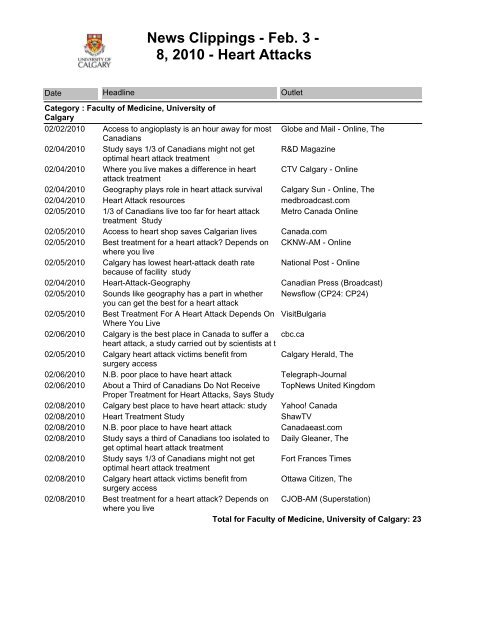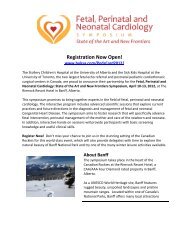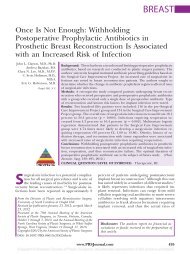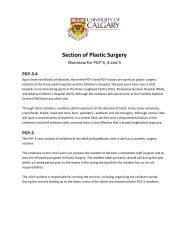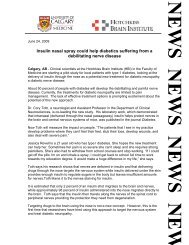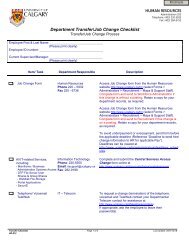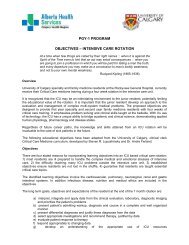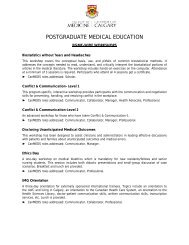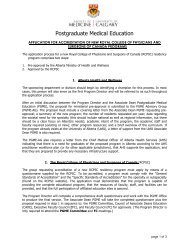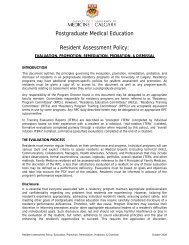News Clippings - Feb. 3 - 8, 2010 - Faculty of Medicine - University ...
News Clippings - Feb. 3 - 8, 2010 - Faculty of Medicine - University ...
News Clippings - Feb. 3 - 8, 2010 - Faculty of Medicine - University ...
Create successful ePaper yourself
Turn your PDF publications into a flip-book with our unique Google optimized e-Paper software.
Headline:Date:Media Contact:Media Outlet:Attachment Link:Access to angioplasty is an hour away for most Canadians2/2/<strong>2010</strong> 12:00:00 AMGlobe and Mail - Online, Thehttp://www.theglobeandmail.com/life/health/access-to-angioplasty-is-an-hour-away-for-mostcanadians/article1453902/Heart attacks64 per cent <strong>of</strong> adults live within an hour <strong>of</strong> a hospital that can do the life-saving heart procedure, saysstudy that calls wider access unrealisticAndré Picard Public Health ReporterGlobe and Mail Update Last updated on Tuesday, <strong>Feb</strong>. 02, <strong>2010</strong> 7:32PM ESTAlmost two-thirds <strong>of</strong> Canadian adults have access to a medical facility that can do emergencyangioplasty within one hour <strong>of</strong> their home, a new study shows.While swift surgery is the best treatment for a common form <strong>of</strong> heart attack, researchers cautioned that,realistically, it probably can’t be provided to everyone in a vast country like Canada.“You can take the glass-half-empty view that this is not good. But I take the glass-half-full view that 64per cent over all is a pretty encouraging number,” said William Ghali, a pr<strong>of</strong>essor in the Centre for Healthand Policy Studies at the <strong>University</strong> <strong>of</strong> Calgary and senior author <strong>of</strong> the study, in an interview.The research, published in the medical journal Open <strong>Medicine</strong>, shows that while access to speedytreatment is pretty good over all for a sprawling, sparsely populated country, there are stark regionaldisparities.For example, only 15.8 per cent <strong>of</strong> New Brunswick residents could, theoretically, be transported promptlyto a hospital that performs angioplasty, also known as primary percutaneous coronary intervention orPCI.By contrast, the figure is 72.6 per cent in Ontario.In the United States, more than 80 per cent <strong>of</strong> adults could get to a PCI within 60 minutes, compared withCanada’s 64 per cent, the study says.Alka Patel, a U <strong>of</strong> C doctoral student and lead author <strong>of</strong> the study, said that while the findings seem topoint to a shortage, they “should not lead to blind enthusiasm” for building more PCI facilities. There is a“trade-<strong>of</strong>f between equity and efficiency,” and the logistics <strong>of</strong> building new facilities are complex, she said.A common deadly form <strong>of</strong> heart attack is ST segment elevation myocardial infarction (STEMI).The recommended treatment is angioplasty, a simple operation in which a balloon catheter is insertedinto an artery in the groin, then snaked up to restore blood flow to the heart.Surgeons commonly say that “time is heart muscle,” meaning that the faster the procedure is done, theless the heart will be damaged. STEMI patients who undergo angioplasty also have much lower rates <strong>of</strong>another heart attack or a stroke.
However, not all STEMI patients are <strong>of</strong>fered the procedure, and the principal reason is that they cannotbe transported to hospital promptly, Dr. Ghali said.This situation had led to the development <strong>of</strong> regional care models, in which transportation and treatment<strong>of</strong> STEMI patients could be expedited, but the study points to major holes in that system.Dr. Ghali said angioplasty can never be <strong>of</strong>fered equitably in a country as large as Canada. But he notedthat, even in rural and remote areas, there are good alternatives such as “drip and ship,” in which heartattack patients are treated with clot-busting drugs, then taken to a larger centre for angioplasty.Research has shown that the time between the onset <strong>of</strong> a heart attack and the reopening <strong>of</strong> an artery –known as door-to-balloon time – should not exceed 90 minutes.In the new study, researchers assumed that if transportation <strong>of</strong> patients was prompt, access to surgerywould be also.There are 40 hospitals in Canada that perform PCI surgery; 14 are in Ontario and 13 in Quebec. None <strong>of</strong>the northern territories nor the province <strong>of</strong> Prince Edward Island have a PCI facility.The researchers used census population data and road network analysis to calculate travel times.In Canada there is one PCI facility for every 595,000 adults; in the United States there is one for every176,000 adults.
Headline:Date:Media Contact:Media Outlet:Attachment Link:Study says 1/3 <strong>of</strong> Canadians might not get optimal heart attack treatment2/4/<strong>2010</strong> 12:00:00 AMShannon MontgomeryR&D Magazinehttp://rdmag.com/<strong>News</strong>/FeedsAP/<strong>2010</strong>/02/life-sciences-study-says-1-3-<strong>of</strong>-canadians-mightnot-get-optimal-/Posted In: Life SciencesJust over one-third <strong>of</strong> Canadians live too far away from a specialized hospital to get the best availabletreatment for a heart attack, suggests a new study.But its authors argue that number is pretty good for a vast, sparsely populated country where manypeople live away from major urban areas.The <strong>University</strong> <strong>of</strong> Calgary researchers looked at how many Canadians 40 years and older live within anhour <strong>of</strong> a hospital that's equipped to perform an emergency angioplasty, a specialized procedure in whichsurgeons open a blocked blood vessel to the heart.More than 70 per cent <strong>of</strong> people in Ontario can access the treatment within an hour, while only 15.8 percent in New Brunswick are within an hour <strong>of</strong> the province's only hospital capable <strong>of</strong> providing thetreatment. Some areas, such as Prince Edward Island and the three territories, don't have a facility thatperforms the procedure.Senior author Dr. William Ghali says the fact that 63.9 per cent <strong>of</strong> Canadians can get access to thesophisticated treatment within an hour is pretty good considering the country's spread-out population."One way to view the number is to view it negatively and say, 'oh, isn't it bad that 35 per cent can't getthere within an hour'," he said."My take is actual more <strong>of</strong> a positive one, that it's quite positive that two-thirds <strong>of</strong> the population can getaccess within an hour."The traditional treatment for a heart attack has been clot-busting drugs, but Ghali has said it's beenrecognized that rapid access to an angioplasty leads to better outcomes.Similar studies in the United States have shown that about 80 per cent <strong>of</strong> its population has similaraccess to the treatment, said Ghali. That country is more densely populated, but also has morespecialized treatment available in community hospitals."For example, a place like Red Deer ... or Lethbridge might actually have angioplasty services in theAmerican health-care system."But Ghali cautioned his study isn't suggesting that's the way to go; rather, he it's information thatgovernment and people can consider when figuring out the best way to spend health-care dollars.It's extremely costly to set up specialized treatment centres, but that's not the only concern."Hospitals that do a lot <strong>of</strong> a procedure tend to have better results than hospitals that do it veryoccasionally. The strong argument against setting up these facilities in small centres is that you can getsubstandard care in places that aren't doing it enough," Ghali said.
"There are trade-<strong>of</strong>fs that we don't have the answers to. But this work is the first step in the dialogue."John Cairns, a cardiologist and pr<strong>of</strong>essor at the <strong>University</strong> <strong>of</strong> British Columbia, said he wasn't surprisedby the numbers found by the study."The third that are not able to get this, that's just the reality <strong>of</strong> living outside <strong>of</strong> a major centre. You can'thave neurosurgery, you can't have advanced transplantation, you can't have everything if you live in anisolated area," he said."So it's a balancing <strong>of</strong> what's affordable and what's possible."Cairns said that most new procedures tend to start out very specialized and slowly become morecommon in smaller hospitals.Ghali also pointed out that rural areas can follow the "drip and ship" method in which a patient is givenclot-busting drugs and sent to the nearly major centre even if it's more than an hour away.Alka Patel, a PhD candidate who led the study, said she'd like to look into whether the availability <strong>of</strong>helicopter ambulances and other air transportation makes a difference in access.Another question is whether there is a correlation between the number <strong>of</strong> people living close to a majorcentre and the number <strong>of</strong> deaths from heart attacks.She said she's encouraged by the results so far."In a country like ours, it's hard to say everyone's going to have access for a service like this. It showsthat with what we have we're doing pretty well."
Headline:Date:Media Contact:Media Outlet:Attachment Link:Where you live makes a difference in heart attack treatment2/4/<strong>2010</strong> 12:00:00 AMCTV Calgary - Onlinehttp://calgary.ctv.ca/servlet/an/local/CTV<strong>News</strong>/<strong>2010</strong>0204/CGY_Heart_Angioplasty_100204/<strong>2010</strong>0204/?hub=CalgaryHomeAccording to a new study from the <strong>University</strong> <strong>of</strong> Calgary, where you live makes a difference when itcomes to quick treatment for heart attacks.Timely access to angioplasty is critical because every minute heart attack sufferers wait, they are losingheart muscle.In Alberta, 63 percent <strong>of</strong> patients who have a heart attack, and need angioplasty, make it to the hospitalwithin an hour.In New Brunswick, just 16 percent <strong>of</strong> patients make it to the hospital within an hour."I was surprised by the differences between the provinces," says researcher Alka Patel. "But when youstart thinking about it, it makes sense because it's a function <strong>of</strong> where your population is and how yourpopulation is distributed."In Alberta, there are three angioplasty treatment centres – one is in Calgary and two are in Edmonton –which means good access for most <strong>of</strong> the population.And while improving access for rural areas <strong>of</strong> the country seems the logical solution to the problem,researchers say it doesn't make sense to <strong>of</strong>fer angioplasty in every small town. "There would betrade<strong>of</strong>fs: system efficiency, dollars involved, the performance, if new cardiologists would need to berecruited," says Dr. William Ghali from the Libin Cardiovascular Institue.When it comes to access, Ontario ranks the best in Canada.In Prince Edward Island, there isn't even a hospital that <strong>of</strong>fers angioplasty.
Headline:Date:Media Contact:Media Outlet:Attachment Link:Geography plays role in heart attack survival2/4/<strong>2010</strong> 12:00:00 AMJENNA McMURRAYCalgary Sun - Online, Thehttp://www.calgarysun.com/news/alberta/<strong>2010</strong>/02/04/12745861.htmlWhen it comes to surviving a heart attack, it’s where you live that counts.New research shows the travel time from a person’s location at the time <strong>of</strong> a heart attack to one <strong>of</strong> the 40Canadian hospitals equipped to open blocked vessels significantly impacts the patient’s chance <strong>of</strong>survival.There are three Alberta hospitals with the specialists to perform the procedure known as a percutaneouscoronary intervention (PCI) or angioplasty, which involves running a wire and a balloon into a blockedartery.Arriving at a hospital within an hour <strong>of</strong> a heart attack and receiving this treatment is considered to be theoptimal means <strong>of</strong> surviving, but in Alberta, the PCI can only be done at the Foothills Medical Centre inCalgary and the <strong>University</strong> <strong>of</strong> Alberta and the Royal Alexandra hospitals in Edmonton.The study showed 63.4% <strong>of</strong> Albertans are within an hour <strong>of</strong> accessing the procedure, said Alka Patel,first author <strong>of</strong> the study and <strong>University</strong> <strong>of</strong> Calgary PhD candidate.The study only looked at ground ambulance transport but Patel said she’d like to include air transport in afollow-up study.Cameron Heke, a spokesman for STARS Air Ambulance said that could make a difference, as 50% <strong>of</strong>STARS’ missions are inter-hospital transport between rural facilities and the Foothills and “a significantnumber <strong>of</strong> that 50% are cardiac and stroke-related patients.”Dr. William Ghali <strong>of</strong> the Libin Cardiovascular Institute <strong>of</strong> Alberta and the Calgary Institute for Populationand Public Health said because the Canadian health system centralizes its resources in denselypopulated areas, smaller cities such as Lethbridge and Red Deer don’t have the specialists to <strong>of</strong>fer PCI,though in the American system they might.Approximately 80% Americans over the age <strong>of</strong> 18 have access to PCI, significantly higher than inCanada, where about 64% <strong>of</strong> people 40 years or older could reach the treatment in the proper time.Ontario residents have the best access in Canada, with 72.6% <strong>of</strong> them living within an hour <strong>of</strong> a PCIfacility.Only 15.8% <strong>of</strong> New Brunswick residents have timely access to the treatment.There are no PCI facilities in Prince Edward Island or any <strong>of</strong> Canada’s three territories.Ghali said having more hospitals equipped to perform PCI would be costly and require more specialistsand high-tech operating suites and could affect performance quality.
Headline:Date:Media Contact:Media Outlet:Attachment Link:Heart Attack resources2/4/<strong>2010</strong> 12:00:00 AMShannon Montgomerymedbroadcast.comhttp://www.medbroadcast.com/channel_health_news_details.asp?channel_id=2060&news_channel_id=1000&news_id=20495&relation_id=0Heart > Health <strong>News</strong> > Study says 1/3 <strong>of</strong> Canadians might not get optimal heart attack treatmentStudy says 1/3 <strong>of</strong> Canadians might not get optimal heart attack treatmentProvided by: The Canadian PressCALGARY - Just over one-third <strong>of</strong> Canadians live too far away from a specialized hospital to get the bestavailable treatment for a heart attack, suggests a new study.But its authors argue that number is pretty good for a vast, sparsely populated country where manypeople live away from major urban areas.The <strong>University</strong> <strong>of</strong> Calgary researchers looked at how many Canadians 40 years and older live within anhour <strong>of</strong> a hospital that's equipped to perform an emergency angioplasty, a specialized procedure in whichsurgeons open a blocked blood vessel to the heart.More than 70 per cent <strong>of</strong> people in Ontario can access the treatment within an hour, while only 15.8 percent in New Brunswick are within an hour <strong>of</strong> the province's only hospital capable <strong>of</strong> providing thetreatment. Some areas, such as Prince Edward Island and the three territories, don't have a facility thatperforms the procedure.Senior author Dr. William Ghali says the fact that 63.9 per cent <strong>of</strong> Canadians can get access to thesophisticated treatment within an hour is pretty good considering the country's spread-out population."One way to view the number is to view it negatively and say, 'oh, isn't it bad that 35 per cent can't getthere within an hour'," he said."My take is actual more <strong>of</strong> a positive one, that it's quite positive that two-thirds <strong>of</strong> the population can getaccess within an hour."The traditional treatment for a heart attack has been clot-busting drugs, but Ghali has said it's beenrecognized that rapid access to an angioplasty leads to better outcomes.Similar studies in the United States have shown that about 80 per cent <strong>of</strong> its population has similaraccess to the treatment, said Ghali. That country is more densely populated, but also has morespecialized treatment available in community hospitals."For example, a place like Red Deer ... or Lethbridge might actually have angioplasty services in theAmerican health-care system."But Ghali cautioned his study isn't suggesting that's the way to go; rather, he it's information thatgovernment and people can consider when figuring out the best way to spend health-care dollars.It's extremely costly to set up specialized treatment centres, but that's not the only concern.
"Hospitals that do a lot <strong>of</strong> a procedure tend to have better results than hospitals that do it veryoccasionally. The strong argument against setting up these facilities in small centres is that you can getsubstandard care in places that aren't doing it enough," Ghali said."There are trade-<strong>of</strong>fs that we don't have the answers to. But this work is the first step in the dialogue."John Cairns, a cardiologist and pr<strong>of</strong>essor at the <strong>University</strong> <strong>of</strong> British Columbia, said he wasn't surprisedby the numbers found by the study."The third that are not able to get this, that's just the reality <strong>of</strong> living outside <strong>of</strong> a major centre. You can'thave neurosurgery, you can't have advanced transplantation, you can't have everything if you live in anisolated area," he said."So it's a balancing <strong>of</strong> what's affordable and what's possible."Cairns said that most new procedures tend to start out very specialized and slowly become morecommon in smaller hospitals.Ghali also pointed out that rural areas can follow the "drip and ship" method in which a patient is givenclot-busting drugs and sent to the nearly major centre even if it's more than an hour away.Alka Patel, a PhD candidate who led the study, said she'd like to look into whether the availability <strong>of</strong>helicopter ambulances and other air transportation makes a difference in access.Another question is whether there is a correlation between the number <strong>of</strong> people living close to a majorcentre and the number <strong>of</strong> deaths from heart attacks.She said she's encouraged by the results so far."In a country like ours, it's hard to say everyone's going to have access for a service like this. It showsthat with what we have we're doing pretty well."
Headline:Date:Media Contact:Media Outlet:Attachment Link:1/3 <strong>of</strong> Canadians live too far for heart attack treatment Study2/5/<strong>2010</strong> 12:00:00 AMMetro Canada Onlinehttp://www.metronews.ca/calgary/local/article/443512--1-3-<strong>of</strong>-canadians-live-too-far-for-heart-attacktreatment-studyA new study says just over a third <strong>of</strong> Canadians live too far away from a specialized hospital to getoptimal treatment for a heart attack.The <strong>University</strong> <strong>of</strong> Calgary research looked at how many Canadians live within an hour <strong>of</strong> a hospital that’sequipped to open a blocked blood vessel to the heart.More than 70 per cent <strong>of</strong> people in Ontario can access the treatment in that time, while some areas, suchas Prince Edward Island and the three territories, don’t have a single facility that performs the procedure.Senior author Dr. William Ghali says the fact that 64 per cent <strong>of</strong> Canadians can access the treatmentwithin an hour is pretty good considering our population.
Headline:Date:Media Contact:Media Outlet:Attachment Link:Access to heart shop saves Calgarian lives2/5/<strong>2010</strong> 12:00:00 AMCanada.comhttp://www2.canada.com/theprovince/news/story.html?id=e6adceb7-f749-4426-94b6-8b9f86a97d7cCalgary residents have the lowest heart attack death rate in the country because <strong>of</strong> access to a 24-hourfacility dedicated to the condition's treatment, according to a study released this week.The study, conducted by researchers at the <strong>University</strong> <strong>of</strong> Calgary's <strong>Faculty</strong> <strong>of</strong> <strong>Medicine</strong>, said Calgariansgained from having Foothills Hospitalprovide a percutaneous coronary intervention treatment -- also known as PCI -- which opens blockedblood vessels connected to the heart.The service is 24 hours at Foothills.The study says almost 64 per cent <strong>of</strong> Canadians have access to such treatments within an hour <strong>of</strong> wherethey live. There are glaring holes in the network, however -- only 16 per cent <strong>of</strong> New Brunswick residentshave quick access to the treatment, and no PCI facilities exist in Prince Edward Island and the threeterritories.
Headline:Date:Media Contact:Media Outlet:Attachment Link:Best treatment for a heart attack? Depends on where you live2/5/<strong>2010</strong> 12:00:00 AMCKNW-AM - Onlinehttp://www.cknw.com/Channels/<strong>News</strong>/Edmonton/Story.aspx?ID=11929083:25amA new study suggests that almost two thirds <strong>of</strong> Canadians live close enough to a specialized hospital toget the best treatment for a heart attack.A group <strong>of</strong> <strong>University</strong> <strong>of</strong> Calgary researchers looked at how many Canadians over the age <strong>of</strong> 40 livewithin an hour <strong>of</strong> a hospital that's equipped to open a blocked blood vessel to the heart.They found that there were big differences by region.More than 70 per cent <strong>of</strong> people in Ontario can access the treatment in that time, while in New Brunswickthat figure hovers under 20 per cent.Some areas, such as Prince Edward Island and the three territories, don't have a single facility thatperforms the procedure.But senior author Doctor William Ghali says the paper isn't arguing for more facilities.He says big hospitals that do the procedure frequently do them better than small hospitals that do themoccasionally, so it doesn't make sense to blindly set up shop in every hospital.Rather, he says, the paper should be part <strong>of</strong> the discussion on the best way to deliver health care in thecountry.
Headline:Date:Media Contact:Media Outlet:Attachment Link:Calgary has lowest heart-attack death rate because <strong>of</strong> facility study2/5/<strong>2010</strong> 12:00:00 AMNational Post - Onlinehttp://www.nationalpost.com/todays-paper/story.html?id=2525966Calgary residents have the lowest heart attack death rate in the country because <strong>of</strong> access to a 24-hourfacility dedicated to the condition's treatment, according to a study released this week. The study,conducted by researchers at the <strong>University</strong> <strong>of</strong> Calgary's <strong>Faculty</strong> <strong>of</strong> <strong>Medicine</strong>, said Calgarians gained fromhaving Foothills Hospital provide a percutaneous coronary intervention treatment -- also known as PCI --which opens blocked blood vessels connected to the heart. The service runs 24 hours at Foothills. Thestudy says almost 64% <strong>of</strong> Canadians have access to such treatments within an hour <strong>of</strong> where they live.
Headline:Date:Media Contact:Media Outlet:Heart-Attack-Geography2/4/<strong>2010</strong> 12:00:00 AMCanadian Press (Broadcast)CALGARY - A new study says just over 1/3 <strong>of</strong> Canadians live too far away from a specialized hospital toget optimal treatment for a heart attack.The <strong>University</strong> <strong>of</strong> Calgary research looked at how many Canadians live within an hour <strong>of</strong> a hospital that'sequipped to open a blocked blood vessel to the heart.More than 70 per cent <strong>of</strong> people in Ontario can access the treatment in that time, while some areas, suchas Prince Edward Island and the three territories, don't have a single facility that performs the procedure.Senior author Dr. William Ghali says the fact that 64 per cent <strong>of</strong> Canadians can access the treatmentwithin an hour is pretty good considering our population.He says some people might use the study to argue that treatment centres should be set up in moresmaller hospitals to improve access.But Ghali says that would be expensive and treatment outcomes likely wouldn't be as good as when theprocedure is done in larger centres.(The Canadian Press)Copyright © <strong>2010</strong> The Canadian Press
Headline:Date:Media Contact:Media Outlet:Attachment Link:Sounds like geography has a part in whether you can get the best for a heartattack2/5/<strong>2010</strong> 4:09:00 PM<strong>News</strong>flow (CP24: CP24)http://www.criticalmention.com/components/url_gen/play_flash.php?clip_info=1248534813|0|70&autoplay=1&clip_id=23198408Sounds like geography has a part in whether you can get the best treatment if you have a heart attack. Astudy finds one third <strong>of</strong> Canadians live too far away from a hospital that performs emergency angioplasty.<strong>University</strong> <strong>of</strong> Calgary researchers looked at how many Canadians 40 years and older live within one hour<strong>of</strong> a hospital equipped to perform the procedure. Good news for Ontario residents, though. More than70% <strong>of</strong> people in this province can access the treatment within an hour. But places like Prince EdwardIsland and the Territories don't have any facility that does it.
Headline:Date:Media Contact:Media Outlet:Attachment Link:Best Treatment For A Heart Attack Depends On Where You Live2/5/<strong>2010</strong> 12:00:00 AMAnna TomovaVisitBulgariahttp://visitbulgaria.info/12541-best-treatment-heart-attack-depends-where-you-liveAccording to a new study, almost two thirds <strong>of</strong> Canadians reside near enough to a specialized hospital,ensuring best treatment in the event <strong>of</strong> an heart attack.Researchers from the <strong>University</strong> <strong>of</strong> Calgary looked at how many 40-plus Canadians lived within an hour<strong>of</strong> a hospital equipped for opening blocked blood vessels to the heart.They found that big differences by region, with over 70% <strong>of</strong> people in Ontario being able to accesstreatment in time, while the figure was far lower at 20% for New Brunswick.Certain areas like Prince Edward Island and the three territories did not have a single facility able toperform the procedure.However, Dr. William Ghali, senior author <strong>of</strong> the paper says they are not making an argument for saysthe paper isn't arguing for more facilities. It is just that big hospitals perform emergency angioplasty morefrequently than smaller hospitals, which only do the procedure on an occasional basis. The fact 63.9% <strong>of</strong>Canadians are able to access the sophisticated treatment within an hour is pretty good, considering thespread-out population <strong>of</strong> the country.While, traditionally heart attack treatment has been mostly clot-busting drugs, however, Ghali said rapidaccess to angioplasty has better outcomes.Rather than asking blindly to set up shop in every hospital, he would like their paper to be made part <strong>of</strong>the discussion, on the best way to deliver health care.
Headline:Date:Media Contact:Media Outlet:Attachment Link:Calgary is the best place in Canada to suffer a heart attack, a study carried outby scientists at t2/6/<strong>2010</strong> 12:00:00 AMcbc.cahttp://news.vocus.com/click/here.pl?z2529316551&z=950246748About 60 per cent <strong>of</strong> Canadians have timely access to life-saving angioplasty, researchers found. (CBC)The reason: Calgarians have quick and easy access to life-saving angioplasty treatment 24 hours a dayat Foothills Medical Centre.One key factor for surviving a heart attack is getting to a hospital that is equipped to open a blockedblood vessel to the heart within one hour, said the study published in the online journal Open <strong>Medicine</strong>.'Treating people immediately with angioplasty can lead to lower death rates and better outcomes,'researcher William Ghali said Thursday.The <strong>University</strong> <strong>of</strong> Calgary researchers found that about 64 per cent <strong>of</strong> Albertans have access to timelytreatment, while about 60 per cent <strong>of</strong> Canadians have access to the treatment also known aspercutaneous coronary intervention.Alka Patel, a researcher at the university, said treatment centres should be located near the largestpopulation. 'Nationally, there are places that could benefit from looking at where is your populationsitting? Can you get someone to a hospital that has these services within a specific time frame?' shesaid. Alberta is on par with the national average. In Ontario, for example, more people live closer to acardiac hospital. Ontario has 14 facilities, where more than 70 per cent <strong>of</strong> adults aged 40 and older haveaccess to angioplasty treatment.In New Brunswick, fewer people live close to a hospital that <strong>of</strong>fers angioplasty. Only 15.8 per cent <strong>of</strong>adults aged 40 and older in New Brunswick have access to the treatment. In the three territories and onPrince Edward Island, there are no facilities.But it is the role that paramedics play that helps get timely treatment in Calgary.In Alberta, Emergency Medical Services employees are trained to read cardiograms, EMS spokesmanDwayne Clayden said.If a patient is having a heart attack, paramedics can bring them straight into surgery rather than having towait for another assessment when they arrive at hospital, he said. 'So what we've essentially been ableto do is cut out that entire emergency time because paramedics can talk to doctors ahead <strong>of</strong> time,'Clayden said. The research also shows that 36 per cent <strong>of</strong> Albertans do not live close enough to ahospital that <strong>of</strong>fers adequate care for heart attacks.In those cases, there are other options. For example, patients can be given medication to break up ablood clot, but their survival rates are reduced.
Headline:Date:Media Contact:Media Outlet:Attachment Link:Calgary heart attack victims benefit from surgery access2/5/<strong>2010</strong> 12:00:00 AMDerworiz, ColeteCalgary Herald, Thehttp://www.calgaryherald.com/health/Calgary+heart+attack+victims+benefit+from+surgery+access/2525721/story.htmlT wo <strong>of</strong> every three Albertans over the age <strong>of</strong> 40 have access to the best treatment for a heart attack,according to a study released Thursday by the <strong>University</strong> <strong>of</strong> Calgary.The research, published this week in the online journal Open <strong>Medicine</strong>, shows 63.9 per cent <strong>of</strong>Canadians can get an angioplasty -- considered the best treatment to improve a patient's chance <strong>of</strong>survival -- within one hour <strong>of</strong> having a heart attack."Ontario and Quebec have the highest access," said Alka Patel, a PhD student at the U <strong>of</strong> C who's thelead author on the study. 'Alberta was close to the national average."It's not how much population is in each province, but it's how the population is distributed,' she added.As a result, Saskatchewan and New Brunswick residents had the least access to the procedure, while63.3 per cent <strong>of</strong> Albertans live within an hour <strong>of</strong> a hospital that <strong>of</strong>fers the treatment.Although the study didn't look at outcomes, it acknowledged prior reports that show Calgary has thelowest heart attack death rate in Canada because Foothills Medical Centre <strong>of</strong>fers the treatment 24 hoursa day, seven days a week.Diana Krescy, chief executive <strong>of</strong> the Heart and Stroke Foundation <strong>of</strong> Alberta, said it's true Calgarianshave one <strong>of</strong> the best survival rates.However, she said it's not good enough that only two-thirds <strong>of</strong> Albertans have access to the treatment."We could do better," she said, noting it's important to keep investing in research since that's what bringstop cardiologists to Alberta and helps to find new technologies that will improve care for others who don'thave the access to the procedure.An angioplasty, which is used to open coronary arteries blocked by a blood clot, requires a specializedteam <strong>of</strong> doctors and nurses in a high-tech operating suite.Dr. William Ghali, a U <strong>of</strong> C pr<strong>of</strong>essor who's the senior author on the study, said they were careful not torecommend that governments put new facilities in place to provide the procedure in other hospitals."There are trade-<strong>of</strong>fs," he said, noting there are higher health-care costs and the potential for safetyconcerns in a smaller facility. 'A province like Alberta needs to think about the merits <strong>of</strong> Lethbridge or RedDeer or Grande Prairie.'Alberta Health Services said there's no plan to expand the number <strong>of</strong> hospitals <strong>of</strong>fering the procedure atthis time.cderworiz@theherald.canwest.comPhoto: Colleen De Neve, Calgary Herald / <strong>University</strong> <strong>of</strong> Calgary student Alka Patel found nearly 64 per
cent <strong>of</strong> Albertans can get an angioplasty within an hour after a heart attack.Copyright © <strong>2010</strong> Calgary Herald
Headline:Date:Media Contact:Media Outlet:Attachment Link:N.B. poor place to have heart attack2/6/<strong>2010</strong> 12:00:00 AMChris MorrisTelegraph-Journalhttp://telegraphjournal.canadaeast.com/rss/article/945602Published Saturday <strong>Feb</strong>ruary 6th, <strong>2010</strong>Health: Study shows just 15.8% <strong>of</strong> people in province live an hour from best treatmentTelegraph-JournalFREDERICTON - A new study says New Brunswick is one <strong>of</strong> the worst places in Canada to have a heartattack, unless the patient is lucky enough to live within an hour <strong>of</strong> Saint John.<strong>University</strong> <strong>of</strong> Calgary researchers released a report on Friday underscoring the disparities that makeAtlantic Canada a have-not region when it comes to emergency cardiac care.The study's authors tracked the number <strong>of</strong> Canadians 40 years <strong>of</strong> age and older who live within an hour<strong>of</strong> hospitals equipped to perform emergency angioplasty, a specialized procedure in which surgeonsopen blocked blood vessels to the heart.In general, almost two-thirds <strong>of</strong> Canadians live close enough to hospitals that can provide the angioplastytreatment, which significantly improves a heart-attack victim's chances for survival and recovery.But the study found that geography plays a big role in who gets access to the state-<strong>of</strong>-the-art treatment.While more than 70 per cent <strong>of</strong> people in Ontario can access the treatment within an hour, only 15.8 percent in New Brunswick are within an hour <strong>of</strong> the province's only hospital capable <strong>of</strong> providing thetreatment - the Saint John Regional.Some areas, such as Prince Edward Island and the three territories, don't have any facilities for the lifesavingprocedure."Time is muscle - heart muscle in this case - and for every minute that goes by, there is a little morepermanent damage to the heart," Dr. William Ghali <strong>of</strong> the Libin Cardiovascular Institue at the <strong>University</strong> <strong>of</strong>Calgary, told The Telegraph-Journal.Ghali, senior author <strong>of</strong> the study, said the traditional treatment for a heart attack has been clot-bustingdrugs, but he said that rapid access to an angioplasty leads to better outcomes.Ghali said his study highlights a basic inequity in Canada when it comes to this kind <strong>of</strong> emergency care."There's no question that for Canadians, equity is one <strong>of</strong> the things we strive for in this country," he said."So certainly where there is a situation that is not geographically equitable, it is unsettling. It doesn't sitquite right with people to realize that therapies available in the cities may not be <strong>of</strong>fered to people in morerural areas."He said there are options New Brunswick could consider to make the situation within the province moreequitable, including establishing a stand-alone angioplasty clinic in Moncton."Moncton is a substantial metropolitan area with over 100,000 people," he said.
"That would enhance the geographic reach a fair bit and would provide some options for P.E.I., whichcurrently has no facilities for the treatment. There is thinking that could be done involving the cardiac carecommunity in New Brunswick and policy makers."Shannon Hagerman, spokeswoman for the Department <strong>of</strong> Health, said it's too early to comment on thestudy."The Department <strong>of</strong> Health will need to review, assess and analyze this report within a provincial context,before being in a position to comment on its findings," she said.Ghali also pointed out that rural areas <strong>of</strong> New Brunswick could follow the "drip and ship" method in whicha patient is given clot-busting drugs and then sent to a treatment centre even if it's more than an houraway."It's another option New Brunswick could consider - keep the current set up and then aggressively adoptmechanisms for dripping and shipping patients," he said.In Alberta, there are three angioplasty treatment centres - one is in Calgary and two are in Edmonton -which means good access for most <strong>of</strong> the population.And while improving access for rural areas <strong>of</strong> the country seems the logical solution to the problem, Ghalisaid it doesn't make sense to <strong>of</strong>fer angioplasty in every small town."There would be trade<strong>of</strong>fs: system efficiency, dollars involved, the performance, if new cardiologistswould need to be recruited," he said.
Headline:Date:Media Contact:Media Outlet:Attachment Link:About a Third <strong>of</strong> Canadians Do Not Receive Proper Treatment for Heart Attacks,Says Study2/6/<strong>2010</strong> 12:00:00 AMTop<strong>News</strong> United Kingdomhttp://topnews.co.uk/22403-about-third-canadians-do-not-receive-proper-treatment-heart-attackssays-studyA latest study has revealed that about a third <strong>of</strong> Canadians live too far away from a medical facility orhospital which is specialized and provides the best available treatment for cardiovascular attacks.The authors <strong>of</strong> the study, however, have argued that the number is pretty good when keeping in view thelarge and sparsely populated country where many people anyways live away from major urban regions.For the sake <strong>of</strong> study, researchers from the <strong>University</strong> <strong>of</strong> Calgary analyzed the number <strong>of</strong> Canadiansaged 40 and above living within an hour <strong>of</strong> a medical facility which is well equipped to undertake anemergency angioplasty, a specialized procedure in which surgeons open a blocked blood vessel to theheart.While over 70% <strong>of</strong> people living in Ontario can gain access to the treatment within an hour's time, onlyabout 15.8% population residing in New Brunswick can do so. Some other area like Prince Edward Islandand the three territories, on the other hand, do not have a facility which performs the treatment."One way to view the number is to view it negatively and say, 'oh, isn't it bad that 35 per cent can't getthere within an hour'. My take is actual more <strong>of</strong> a positive one, that it's quite positive that two-thirds <strong>of</strong> thepopulation can get access within an hour", said Senior Author Dr. William Ghali.
Headline:Date:Media Contact:Media Outlet:Attachment Link:Calgary best place to have heart attack: study2/8/<strong>2010</strong> 1:12:00 PMYahoo! Canadahttp://ca.news.yahoo.com/s/cbc/100205/science/canada_calgary_calgary_heart_attack_angioplastySASKATCHEWAN (CBC) - Calgary is the best place in Canada to suffer a heart attack, a study carriedout by scientists at the <strong>University</strong> <strong>of</strong> Calgary faculty <strong>of</strong> medicine suggests.The reason: Calgarians have quick and easy access to life-saving angioplasty treatment 24 hours a dayat Foothills Medical Centre.One key factor for surviving a heart attack is getting to a hospital that is equipped to open a blockedblood vessel to the heart within one hour, said the study published in the online journal Open <strong>Medicine</strong>."Treating people immediately with angioplasty can lead to lower death rates and better outcomes,"researcher William Ghali said Thursday.The <strong>University</strong> <strong>of</strong> Calgary researchers found that about 64 per cent <strong>of</strong> Albertans have access to timelytreatment, while about 60 per cent <strong>of</strong> Canadians have access to the treatment also known aspercutaneous coronary intervention.Alka Patel, a researcher at the university, said treatment centres should be located near the largestpopulation."Nationally, there are places that could benefit from looking at where is your population sitting? Can youget someone to a hospital that has these services within a specific time frame?" she said.Alberta is on par with the national average. In Ontario, for example, more people live closer to a cardiachospital. Ontario has 14 facilities, where more than 70 per cent <strong>of</strong> adults aged 40 and older have accessto angioplasty treatment.In New Brunswick, fewer people live close to a hospital that <strong>of</strong>fers angioplasty. Only 15.8 per cent <strong>of</strong>adults aged 40 and older in New Brunswick have access to the treatment. In the three territories and onPrince Edward Island, there are no facilities.But it is the role that paramedics play that helps get timely treatment in Calgary.In Alberta, Emergency Medical Services employees are trained to read cardiograms, EMS spokesmanDwayne Clayden said.
If a patient is having a heart attack, paramedics can bring them straight into surgery rather than having towait for another assessment when they arrive at hospital, he said."So what we've essentially been able to do is cut out that entire emergency time because paramedicscan talk to doctors ahead <strong>of</strong> time," Clayden said.The research also shows that 36 per cent <strong>of</strong> Albertans do not live close enough to a hospital that <strong>of</strong>fersadequate care for heart attacks.In those cases, there are other options. For example, patients can be given medication to break up ablood clot, but their survival rates are reduced.
Headline:Date:Media Contact:Media Outlet:Attachment Link:Heart Treatment Study2/8/<strong>2010</strong> 1:14:00 PMWolansky, LisaShawTVhttp://start.shaw.ca/Start/enCA/Videos/FeaturedVideos.htm?NRMODE=Published&NRNODEGUID=%7bA0BB5630-EAFE-4F8B-9D52-78105E5D8967%7d&NRORIGINALURL=%2fstart%2fenCA%2fvideos%2ffeaturedvideos.htm%3ffvPgID%3d%7b764490F7-4F60-465C-8686-CE55D51B52F7%7d%26fvTitle%3dHeart%2520Treatment%2520Study%26href3D171C4BD6BC%3dmms%253A%252F%252Fprdmediax1.shaw.ca%252FStart%252FShawTV%252FCalgary%252F<strong>Feb</strong>05%252F05hear.wmv&NRCACHEHINT=Guest&fvPgID=%7b764490F7-4F60-465C-8686-CE55D51B52F7%7d&fvTitle=Heart+Treatment+Study&href3D171C4BD6BC=mms%3a%2f%2fprdmediax1.shaw.ca%2fStart%2fShawTV%2fCalgary%2f<strong>Feb</strong>05%2f05hear.wmv&detection=declinedA recent study is showing the majority <strong>of</strong> Canadians don't have access to optimal life saving hearttreatment.
Headline:Date:Media Contact:Media Outlet:Attachment Link:N.B. poor place to have heart attack2/8/<strong>2010</strong> 3:16:00 PMCanadaeast.comhttp://telegraphjournal.canadaeast.com/rss/article/945602Health: Study shows just 15.8% <strong>of</strong> people in province live an hour from best treatmentA1Chris MorrisTelegraph-JournalStumble Upondel.icio.usDiggFacebookPrintEmail13 Comment(s)FREDERICTON - A new study saysNew Brunswick is one <strong>of</strong> the worst places in Canada to have a heart attack, unless the patient is luckyenough to live within an hour <strong>of</strong> Saint John.<strong>University</strong> <strong>of</strong> Calgary researchers released a report on Friday underscoring the disparities that makeAtlantic Canada a have-not region when it comes to emergency cardiac care.The study's authors tracked the number <strong>of</strong> Canadians 40 years <strong>of</strong> age and older who live within an hour<strong>of</strong> hospitals equipped to perform emergency angioplasty, a specialized procedure in which surgeonsopen blocked blood vessels to the heart.In general, almost two-thirds <strong>of</strong> Canadians live close enough to hospitals that can provide the angioplastytreatment, which significantly improves a heart-attack victim's chances for survival and recovery.But the study found that geography plays a big role in who gets access to the state-<strong>of</strong>-the-art treatment.While more than 70 per cent <strong>of</strong> people in Ontario can access the treatment within an hour, only 15.8 percent in New Brunswick are within an hour <strong>of</strong> the province's only hospital capable <strong>of</strong> providing thetreatment - the Saint John Regional.Some areas, such as Prince Edward Island and the three territories, don't have any facilities for the lifesavingprocedure."Time is muscle - heart muscle in this case - and for every minute that goes by, there is a little morepermanent damage to the heart," Dr. William Ghali <strong>of</strong> the Libin Cardiovascular Institue at the <strong>University</strong> <strong>of</strong>Calgary, told The Telegraph-Journal.Ghali, senior author <strong>of</strong> the study, said the traditional treatment for a heart attack has been clot-bustingdrugs, but he said that rapid access to an angioplasty leads to better outcomes.Ghali said his study highlights a basic inequity in Canada when it comes to this kind <strong>of</strong> emergency care."There's no question that for Canadians, equity is one <strong>of</strong> the things we strive for in this country," he said."So certainly where there is a situation that is not geographically equitable, it is unsettling. It doesn't sitquite right with people to realize that therapies available in the cities may not be <strong>of</strong>fered to people in morerural areas."He said there are options New Brunswick could consider to make the situation within the province moreequitable, including establishing a stand-alone angioplasty clinic in Moncton."Moncton is a substantial metropolitan area with over 100,000 people," he said."That would enhance the geographic reach a fair bit and would provide some options for P.E.I., which
currently has no facilities for the treatment. There is thinking that could be done involving the cardiac carecommunity in New Brunswick and policy makers."Shannon Hagerman, spokeswoman for the Department <strong>of</strong> Health, said it's too early to comment on thestudy."The Department <strong>of</strong> Health will need to review, assess and analyze this report within a provincial context,before being in a position to comment on its findings," she said.Ghali also pointed out that rural areas <strong>of</strong> New Brunswick could follow the "drip and ship" method in whicha patient is given clot-busting drugs and then sent to a treatment centre even if it's more than an houraway."It's another option New Brunswick could consider - keep the current set up and then aggressively adoptmechanisms for dripping and shipping patients," he said.In Alberta, there are three angioplasty treatment centres - one is in Calgary and two are in Edmonton -which means good access for most <strong>of</strong> the population.And while improving access for rural areas <strong>of</strong> the country seems the logical solution to the problem, Ghalisaid it doesn't make sense to <strong>of</strong>fer angioplasty in every small town."There would be trade<strong>of</strong>fs: system efficiency, dollars involved, the performance, if new cardiologistswould need to be recruited," he said.- with files from The Canadian Press
Headline:Date:Media Contact:Media Outlet:Attachment Link:Study says a third <strong>of</strong> Canadians too isolated to get optimal heart attack treatment2/8/<strong>2010</strong> 3:19:00 PMDaily Gleaner, Thehttp://dailygleaner.canadaeast.com/rss/article/945760Study says a third <strong>of</strong> Canadians too isolated to get optimal heart attack treatmentPublished Saturday <strong>Feb</strong>ruary 6th, <strong>2010</strong>C6By SHANNON MONTGOMERYThe Canadian PressStumble Upondel.icio.usDiggFacebookPrintEmailSpeak UpCALGARY - Just over one-third <strong>of</strong> Canadianslive too far away from a specialized hospital to get the best available treatment for a heart attack,suggests a new study.But its authors argue that number is pretty good for a vast, sparsely populated country where manypeople live away from major urban areas.The <strong>University</strong> <strong>of</strong> Calgary researchers looked at how many Canadians 40 years and older live within anhour <strong>of</strong> a hospital that's equipped to perform an emergency angioplasty, a specialized procedure in whichsurgeons open a blocked blood vessel to the heart.More than 70 per cent <strong>of</strong> people in Ontario can access the treatment within an hour, while only 15.8 percent in New Brunswick are within an hour <strong>of</strong> the province's only hospital capable <strong>of</strong> providing thetreatment. Some areas, such as Prince Edward Island and the three territories, don't have a facility thatperforms the procedure.Senior author Dr. William Ghali says the fact that 63.9 per cent <strong>of</strong> Canadians can get access to thesophisticated treatment within an hour is pretty good considering the country's spread-out population."One way to view the number is to view it negatively and say, 'oh, isn't it bad that 35 per cent can't getthere within an hour'," he said."My take is actual more <strong>of</strong> a positive one, that it's quite positive that two-thirds <strong>of</strong> the population can getaccess within an hour."The traditional treatment for a heart attack has been clot-busting drugs, but Ghali has said it's beenrecognized that rapid access to an angioplasty leads to better outcomes.Similar studies in the United States have shown that about 80 per cent <strong>of</strong> its population has similaraccess to the treatment, said Ghali. That country is more densely populated, but also has morespecialized treatment available in community hospitals."For example, a place like Red Deer ... or Lethbridge might actually have angioplasty services in theAmerican health-care system."But Ghali cautioned his study isn't suggesting that's the way to go; rather, he it's information thatgovernment and people can consider when figuring out the best way to spend health-care dollars.It's extremely costly to set up specialized treatment centres, but that's not the only concern."Hospitals that do a lot <strong>of</strong> a procedure tend to have better results than hospitals that do it veryoccasionally.
Headline:Date:Media Contact:Media Outlet:Attachment Link:Study says 1/3 <strong>of</strong> Canadians might not get optimal heart attack treatment2/8/<strong>2010</strong> 3:40:00 PMFort Frances Timeshttp://www.fftimes.com/node/230980Study says 1/3 <strong>of</strong> Canadians might not get optimal heart attack treatmentA A A - text sizeFriday, 5 <strong>Feb</strong>ruary <strong>2010</strong> - 9:06amCALGARY - Just over one-third <strong>of</strong> Canadians live too far away from a specialized hospital to get the bestavailable treatment for a heart attack, suggests a new study.But its authors argue that number is pretty good for a vast, sparsely populated country where manypeople live away from major urban areas.The <strong>University</strong> <strong>of</strong> Calgary researchers looked at how many Canadians 40 years and older live within anhour <strong>of</strong> a hospital that's equipped to perform an emergency angioplasty, a specialized procedure in whichsurgeons open a blocked blood vessel to the heart.More than 70 per cent <strong>of</strong> people in Ontario can access the treatment within an hour, while only 15.8 percent in New Brunswick are within an hour <strong>of</strong> the province's only hospital capable <strong>of</strong> providing thetreatment. Some areas, such as Prince Edward Island and the three territories, don't have a facility thatperforms the procedure.Senior author Dr. William Ghali says the fact that 63.9 per cent <strong>of</strong> Canadians can get access to thesophisticated treatment within an hour is pretty good considering the country's spread-out population."One way to view the number is to view it negatively and say, 'oh, isn't it bad that 35 per cent can't getthere within an hour'," he said."My take is actual more <strong>of</strong> a positive one, that it's quite positive that two-thirds <strong>of</strong> the population can getaccess within an hour."The traditional treatment for a heart attack has been clot-busting drugs, but Ghali has said it's beenrecognized that rapid access to an angioplasty leads to better outcomes.Similar studies in the United States have shown that about 80 per cent <strong>of</strong> its population has similaraccess to the treatment, said Ghali. That country is more densely populated, but also has morespecialized treatment available in community hospitals."For example, a place like Red Deer ... or Lethbridge might actually have angioplasty services in theAmerican health-care system."
But Ghali cautioned his study isn't suggesting that's the way to go; rather, he it's information thatgovernment and people can consider when figuring out the best way to spend health-care dollars.It's extremely costly to set up specialized treatment centres, but that's not the only concern."Hospitals that do a lot <strong>of</strong> a procedure tend to have better results than hospitals that do it veryoccasionally. The strong argument against setting up these facilities in small centres is that you can getsubstandard care in places that aren't doing it enough," Ghali said."There are trade-<strong>of</strong>fs that we don't have the answers to. But this work is the first step in the dialogue."John Cairns, a cardiologist and pr<strong>of</strong>essor at the <strong>University</strong> <strong>of</strong> British Columbia, said he wasn't surprisedby the numbers found by the study."The third that are not able to get this, that's just the reality <strong>of</strong> living outside <strong>of</strong> a major centre. You can'thave neurosurgery, you can't have advanced transplantation, you can't have everything if you live in anisolated area," he said."So it's a balancing <strong>of</strong> what's affordable and what's possible."Cairns said that most new procedures tend to start out very specialized and slowly become morecommon in smaller hospitals.Ghali also pointed out that rural areas can follow the "drip and ship" method in which a patient is givenclot-busting drugs and sent to the nearly major centre even if it's more than an hour away.Alka Patel, a PhD candidate who led the study, said she'd like to look into whether the availability <strong>of</strong>helicopter ambulances and other air transportation makes a difference in access.Another question is whether there is a correlation between the number <strong>of</strong> people living close to a majorcentre and the number <strong>of</strong> deaths from heart attacks.She said she's encouraged by the results so far."In a country like ours, it's hard to say everyone's going to have access for a service like this. It showsthat with what we have we're doing pretty well."
Headline:Date:Media Contact:Media Outlet:Attachment Link:Calgary heart attack victims benefit from surgery access2/8/<strong>2010</strong> 3:50:00 PMOttawa Citizen, Thehttp://www.ottawacitizen.com/health/Calgary+heart+attack+victims+benefit+from+surgery+access/2525721/story.htmlCalgary heart attack victims benefit from surgery accessBy Colete Derworiz, Calgary Herald<strong>Feb</strong>ruary 5, <strong>2010</strong>StoryPhotos ( 1 )<strong>University</strong> <strong>of</strong> Calgary <strong>Faculty</strong> <strong>of</strong> <strong>Medicine</strong> PhD candidate Alka Patel, seen here outside the FoothillsHospital Emergency Room on <strong>Feb</strong>ruary 4, <strong>2010</strong>, helped author a study which found the Canadians haverate <strong>of</strong> survival from heart attacks if they are located close to medical facilities needed to treat them withpercutaneous coronary intervention (PCI). The study also found that Calgary had the lowest heart attackdeath rate in Canada because <strong>of</strong> the access to the Foothills Hospitals Medical Centre which <strong>of</strong>fers PCI24-hours a day and seven days a week.Photograph by: Colleen De Neve, Calgary HeraldTwo <strong>of</strong> everythree Albertans over the age <strong>of</strong> 40 have access to the best treatment for a heart attack, according to astudy released Thursday by the <strong>University</strong> <strong>of</strong> Calgary.The research, published this week in the online journal Open <strong>Medicine</strong>, shows 63.9 per cent <strong>of</strong>Canadians can get an angioplasty -- considered the best treatment to improve a patient's chance <strong>of</strong>survival -- within one hour <strong>of</strong> having a heart attack."Ontario and Quebec have the highest access," said Alka Patel, a PhD student at the U <strong>of</strong> C who's thelead author on the study. "Alberta was close to the national average."It's not how much population is in each province, but it's how the population is distributed," she added.As a result, Saskatchewan and New Brunswick residents had the least access to the procedure, while63.3 per cent <strong>of</strong> Albertans live within an hour <strong>of</strong> a hospital that <strong>of</strong>fers the treatment.Although the study didn't look at outcomes, it acknowledged prior reports that show Calgary has thelowest heart attack death rate in Canada because Foothills Medical Centre <strong>of</strong>fers the treatment 24 hoursa day, seven days a week.Diana Krescy, chief executive <strong>of</strong> the Heart and Stroke Foundation <strong>of</strong> Alberta, said it's true Calgarianshave one <strong>of</strong> the best survival rates.However, she said it's not good enough that only two-thirds <strong>of</strong> Albertans have access to the treatment."We could do better," she said, noting it's important to keep investing in research since that's what bringstop cardiologists to Alberta and helps to find new technologies that will improve care for others who don'thave the access to the procedure.An angioplasty, which is used to open coronary arteries blocked by a blood clot, requires a specializedteam <strong>of</strong> doctors and nurses in a high-tech operating suite.Dr. William Ghali, a U <strong>of</strong> C pr<strong>of</strong>essor who's the senior author on the study, said they were careful not to
ecommend that governments put new facilities in place to provide the procedure in other hospitals."There are trade-<strong>of</strong>fs," he said, noting there are higher health-care costs and the potential for safetyconcerns in a smaller facility. "A province like Alberta needs to think about the merits <strong>of</strong> Lethbridge orRed Deer or Grande Prairie."Alberta Health Services said there's no plan to expand the number <strong>of</strong> hospitals <strong>of</strong>fering the procedure atthis time.cderworiz@theherald.canwest.com© Copyright (c) The Calgary Herald
Headline:Date:Media Contact:Media Outlet:Attachment Link:Best treatment for a heart attack? Depends on where you live2/8/<strong>2010</strong> 3:56:00 PMWeibe, AshleyCJOB-AM (Superstation)http://www.cjob.com/Channels/<strong>News</strong>/Edmonton/story.aspx?ID=1192908Best treatment for a heart attack? Depends on where you live3:25amClick here to email Ashley Wiebe2/5/<strong>2010</strong>A new study suggests that almost two thirds <strong>of</strong> Canadians live close enough to a specialized hospital toget the best treatment for a heart attack.A group <strong>of</strong> <strong>University</strong> <strong>of</strong> Calgary researchers looked at how many Canadians over the age <strong>of</strong> 40 livewithin an hour <strong>of</strong> a hospital that's equipped to open a blocked blood vessel to the heart.They found that there were big differences by region.More than 70 per cent <strong>of</strong> people in Ontario can access the treatment in that time, while in New Brunswickthat figure hovers under 20 per cent.Some areas, such as Prince Edward Island and the three territories, don't have a single facility thatperforms the procedure.But senior author Doctor William Ghali says the paper isn't arguing for more facilities.He says big hospitals that do the procedure frequently do them better than small hospitals that do themoccasionally, so it doesn't make sense to blindly set up shop in every hospital.Rather, he says, the paper should be part <strong>of</strong> the discussion on the best way to deliver health care in thecountry.


